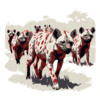Malware: Difference between revisions
From GCA ACT
Jump to navigationJump to search
No edit summary |
No edit summary |
||
| Line 9: | Line 9: | ||
|- | |- | ||
| valign="top" | <big>'''Types of Malware'''</big><br> | | valign="top" | <big>'''Types of Malware'''</big><br> | ||
[[File:Virus_Icon.svg|frameless|40px]] '''Viruses''': Viruses are self-replicating programs that attach themselves to legitimate files or software. When the infected file is executed, the virus spreads to other files and can cause a range of damage, from data corruption to system crashes. | |||
* '''Worms''': Worms are standalone malware programs that spread across networks and devices by exploiting vulnerabilities. Unlike viruses, worms do not need to attach to files to propagate. They can rapidly infect numerous devices, leading to network congestion and data theft. | * '''Worms''': Worms are standalone malware programs that spread across networks and devices by exploiting vulnerabilities. Unlike viruses, worms do not need to attach to files to propagate. They can rapidly infect numerous devices, leading to network congestion and data theft. | ||
* '''Trojans''': Trojans, named after the Trojan Horse from Greek mythology, are deceptive malware programs that appear to be legitimate software but carry hidden malicious payloads. Once installed, they can steal sensitive data, grant remote access to attackers, or perform other malicious actions. | * '''Trojans''': Trojans, named after the Trojan Horse from Greek mythology, are deceptive malware programs that appear to be legitimate software but carry hidden malicious payloads. Once installed, they can steal sensitive data, grant remote access to attackers, or perform other malicious actions. | ||
